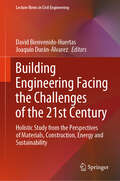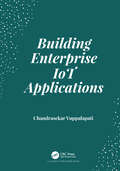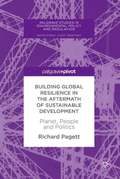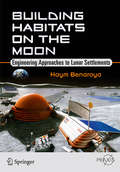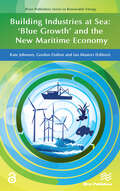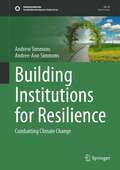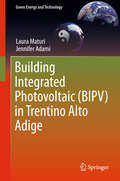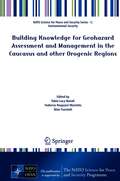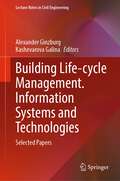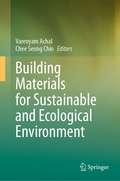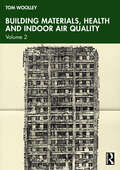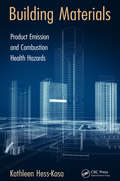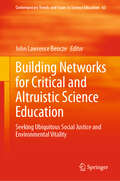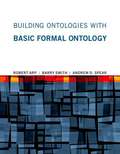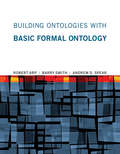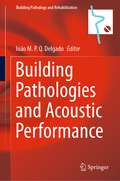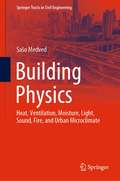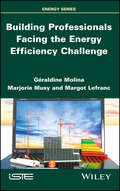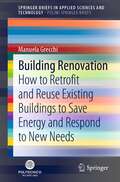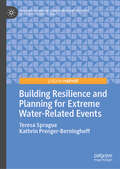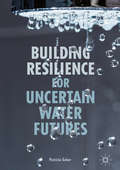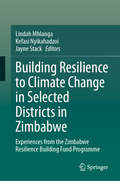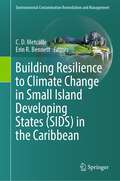- Table View
- List View
Building Engineering Facing the Challenges of the 21st Century: Holistic Study from the Perspectives of Materials, Construction, Energy and Sustainability (Lecture Notes in Civil Engineering #345)
by David Bienvenido-Huertas Joaquín Durán-ÁlvarezBuilding engineering is a complex and constantly evolving branch. The needs of the XXI century society cause a constant change in construction industry due to the need to achieve sustainable and ecological buildings. This affects all levels and phases of this engineering. Given this circumstance, numerous researchers turn their efforts to find optimal solutions for building engineering. For this reason, in this book a holistic analysis of building engineering is carried out from the perspectives that have a greater weight for sustainability objectives. The book is divided into 6 sections: (i) Building materials, which deals with research related to the most innovative and sustainable building materials; (ii) Design and construction, which deals with existing methodologies and advances in design and construction in construction sector; (iii) Building repair and maintenance, which deals with building repair, maintenance and upkeep techniques; (iv) Energy efficiency, which analyses the latest research on the energy efficiency of buildings and their behaviour in the face of climate change; (v) Sustainability, which analyses the establishment of measures to achieve a more sustainable built environment; and (vi) construction management, which compiles the latest studies in the field of Project manager. The 38 chapters of the book together constitute an advance for the topic of building engineering. The aspects covered in the book are of great interest to various sectors, such as researchers, engineers, architects, legislators and interested parties.
Building Enterprise IoT Applications
by Chandrasekar VuppalapatiMcKinsey Global Institute predicts Internet of Things (IoT) could generate up to $11.1 trillion a year in economic value by 2025. Gartner Research Company expects 20 billion inter-connected devices by 2020 and, as per Gartner, the IoT will have a significant impact on the economy by transforming many enterprises into digital businesses and facilitating new business models, improving efficiency and increasing employee and customer engagement. It’s clear from above and our research that the IoT is a game changer and will have huge positive impact in foreseeable future. In order to harvest the benefits of IoT revolution, the traditional software development paradigms must be fully upgraded. The mission of our book, is to prepare current and future software engineering teams with the skills and tools to fully utilize IoT capabilities. The book introduces essential IoT concepts from the perspectives of full-scale software development with the emphasis on creating niche blue ocean products. It also: Outlines a fundamental full stack architecture for IoT Describes various development technologies in each IoT layer Explains IoT solution development from Product management perspective Extensively covers security and applicable threat models as part of IoT stack The book provides details of several IoT reference architectures with emphasis on data integration, edge analytics, cluster architectures and closed loop responses.
Building Global Resilience in the Aftermath of Sustainable Development: Planet, People and Politics (Palgrave Studies in Environmental Policy and Regulation)
by Richard PagettThis book explains why the concept of sustainable development needs to be consigned to history. Using examples from around the world, Richard Pagett illustrates how so-called sustainable development has simply been a cul-de-sac, condemning millions to continuing extreme poverty. Building Global Resilience in the Aftermath of Sustainable Development highlights the futility of current governance systems in meeting modern day global challenges. It also explains the changes that are necessary for a more just and equitable economic societal model, with planetary limits at its core, to further the resilience of communities and society at large. These changes are crucial to confronting the existential threats posed by climate change, resource depletion and overpopulation. This book will be of particular interest to practitioners of environmental management and to anyone concerned for the future of the planet.
Building Habitats on the Moon: Engineering Approaches to Lunar Settlements (Springer Praxis Books)
by Haym BenaroyaDesigning a habitat for the lunar surface? You will need to know more than structural engineering. There are the effects of meteoroids, radiation, and low gravity. Then there are the psychological and psychosocial aspects of living in close quarters, in a dangerous environment, far away from home. All these must be considered when the habitat is sized, materials specified, and structure designed. This book provides an overview of various concepts for lunar habitats and structural designs and characterizes the lunar environment - the technical and the nontechnical. The designs take into consideration psychological comfort, structural strength against seismic and thermal activity, as well as internal pressurization and 1/6 g. Also discussed are micrometeoroid modeling, risk and redundancy as well as probability and reliability, with an introduction to analytical tools that can be useful in modeling uncertainties.
Building Hawaii’s Innovation Economy: Summary of a Symposium
by Charles W. WessnerResponding to the challenges of fostering regional growth and employment in an increasingly competitive global economy, many U. S. states and regions have developed programs to attract and grow companies as well as attract the talent and resources necessary to develop innovation clusters. These state and regionally based initiatives have a broad range of goals and increasingly include significant resources, often with a sectoral focus and often in partnership with foundations and universities. These are being joined by recent initiatives to coordinate and concentrate investments from a variety of federal agencies that provide significant resources to develop regional centers of innovation, business incubators, and other strategies to encourage entrepreneurship and high-tech development. Building Hawaii's Innovation Economy: Summary of a Symposium explains the study of selected state and regional programs in order to identify best practices with regard to their goals, structures, instruments, modes of operation, synergies across private and public programs, funding mechanisms and levels, and evaluation efforts. This report reviews selected state and regional efforts to capitalize on federal and state investments in areas of critical national needs. Building Hawaii's Innovation Economy also reviews efforts to strengthen existing industries as well as specific new technology focus areas such as nanotechnology, stem cells, and energy in order to better understand program goals, challenges, and accomplishments.
Building Industries at Sea - ‘Blue Growth’ and the New Maritime Economy
by Kate Johnson Gordon Dalton Ian MastersThroughout the world there is evidence of mounting interest in marine resources and new maritime industries to create jobs, economic growth and to help in the provision of energy and food security. Expanding populations, insecurity of traditional sources of supply and the effects of climate change add urgency to a perceived need to address and overcome the serious challenges of working in the maritime environment. Four promising areas of activity for ‘Blue Growth’ have been identified at European Union policy level including Aquaculture; Renewable Energy (offshore wind, wave and tide); Seabed Mining; and Blue Biotechnology. Work has started to raise the technological and investment readiness levels (TRLs and IRLs) of these prospective industries drawing on the experience of established maritime industries such as Offshore Oil and Gas; Shipping; Fisheries and Tourism. An accord has to be struck between policy makers and regulators on the one hand, anxious to direct research and business incentives in effective and efficient directions, and developers, investors and businesses on the other, anxious to reduce the risks of such potentially profitable but innovative investments.The EU H2020 MARIBE (Marine Investment for the Blue Economy) funded project was designed to identify the key technical and non-technical challenges facing maritime industries and to place them into the social and economic context of the coastal and ocean economy. MARIBE went on to examine with companies, real projects for the combination of marine industry sectors into multi-use platforms (MUPs). The purpose of this book is to publish the detailed analysis of each prospective and established maritime business sector. Sector experts working to a common template explain what these industries are, how they work, their prospects to create wealth and employment, and where they currently stand in terms of innovation, trends and their lifecycle. The book goes on to describe progress with the changing regulatory and planning regimes in the European Sea Basins including the Caribbean where there are significant European interests. The book includes:• Experienced chapter authors from a truly multidisciplinary team of sector specialisms• First extensive study to compare and contrast traditional Blue Economy with Blue Growth• Complementary to EU and National policies for multi-use of maritime space
Building Institutions for Resilience: Combatting Climate Change (Sustainable Development Goals Series)
by Andrew Simmons Andree-Ann SimmonsThis volume uses a case study approach to present data on the relevance and effectiveness of the strategic actions implemented by NGOs, IGOs and governments at national, regional, and international scales, drawing lessons and recommendations to enhance the capacity of governments and institutions to deliver on climate change adaptation and sustainable development initiatives. The authors provide insights to policymakers, community leaders, students and researchers working on climate change adaptation and resilience-building practices and strategies in vulnerable communities, including small island developing states and post-conflict states, focusing on innovative management practices and institutional capacity building. The cases presented here provide insights into how institutions can strengthen local, national, and regional capacities to adapt to climate change and other calamities.
Building Integrated Photovoltaic (BIPV) in Trentino Alto Adige
by Laura Maturi Jennifer AdamiThis book describes exemplary selected projects carried out in the Trentino-Alto Adige region (Italy) exploring numerous building-integrated photovoltaics (BIPV) systems (i.e. modules, construction system, energy systems). It presents 18 case studies analyzing three aspects of PV integration: aesthetic, energy and technology, with information on decision-making, design process and lessons learnt given for each, along with several pictures, including of general system and architectural details. Based on interviews with architects and engineers, experts from façade/glass manufacturers, energy consultants, BIPV experts, PV installers, electricians, private and public building owners and real estate companies, the book provides a source of inspiration and technical knowledge for architects and engineers towards an increased use of PV in architecture.
Building Knowledge for Geohazard Assessment and Management in the Caucasus and other Orogenic Regions (NATO Science for Peace and Security Series C: Environmental Security)
by Fabio Luca Bonali Federico Pasquaré Mariotto Nino TsereteliThis volume is aimed at providing a comprehensive overview of the state of art of research related to geo-related hazards in the Caucasus and other orogenic regions; it is also devoted to shedding light on a broad array of geological phenomena as well as discussing innovative tools and strategies for geohazard assessment. Additional emphasis is placed on preventive and mitigation measures, which might be helpful in tackling seismic, volcanic and landslide risks affecting major lifelines and infrastructures. The innovative, multidisciplinary methodologies illustrated in this volume may be successfully applied to other orogenic regions across the globe. The book features major scientific contributions from experts working on different Earth Science topics, such as seismology, structural geology, applied geology and volcanology. Its chapters describe a wide gamut of cutting-edge research methodologies and are thus intended to be read and shared by the worldwide Earth Science community. In particular, the readers will have a chance to gain a thorough knowledge of a number of key geological features that can be observed across both the Greater and Lesser Caucasus. Moreover, the volume provides a thorough description of the techniques employed to assess seismic hazard in major cities - such as microzonation - and an overview of the efforts taken to monitor and prevent seismic and landslide hazard posed to vital energy infrastructures in the Caucasus region.
Building Life-cycle Management. Information Systems and Technologies: Selected Papers (Lecture Notes in Civil Engineering #231)
by Alexander Ginzburg Kashevarova GalinaThis book gathers the latest advances, innovations, and applications in the field of information systems and construction engineering, as presented by researchers and engineers at the International Scientific Conference Building Life-cycle Management. Information Systems and Technologies, held in Moscow, Russia on November 26, 2021. It covers highly diverse topics, including Information modeling technologies in building life-cycle management, Mathematical models and methods for building life-cycle management, Management of organizational processes in construction. The contributions, which were selected by means of a rigorous international peer-review process, highlight numerous exciting ideas that will spur novel research directions and foster multidisciplinary collaborations in the construction industry.
Building Marble Runs (Fun STEM Challenges)
by Marne VenturaWhat does it take to make a marble run? Gather some supplies and try it out for yourself! Discover tips and ideas on how to build the best marble run around!
Building Materials for Sustainable and Ecological Environment
by Varenyam Achal Chee Seong ChinThis book uses theories, hypotheses, policies, practical insights and case studies to introduce and elucidate green building materials for sustainable construction. Cement is the most widely used building material in construction; however, it is not sustainable, being responsible for 7% of global carbon dioxide emissions and consuming huge quantities of energy. In order to limit the ecological damage, sustainable building materials are needed. Ecosystems are a source of important lessons and models for transitioning the built environment onto a sustainable path that opens options for sustainable building material in construction. The book provides a guide for readers seeking knowledge on sustainable building materials with the potential to lower environmental impact by reducing CO2 emission throughout the building’s lifecycle. The book is motivated by recent rapid advances in sustainable building materials production, including green building materials made of industrial by-products and recycled wastes, earth materials, plant-based materials, microbial-based materials or supplementary cementitious materials, to reduce the environmental impacts of traditional building materials. Discussing the development and applications of various sustainable building materials, including related case studies, and addressing the environmental issue with a holistic and systematic approach that creates an ecology of construction for sustainability in infrastructures, it offers promising solutions to achieve renewable and sustainable building materials for the future.
Building Materials, Health and Indoor Air Quality: Volume 2
by Tom WoolleyIn Building Materials, Health and Indoor Air Quality: Volume 2 Tom Woolley uses new research to continue to advocate for limiting the use of hazardous materials in construction and raise awareness of the links between pollutants found in building materials, poor indoor air quality and health problems. Chapters in this volume reinforce previous arguments and present new ones covering: Further evidence of the health impacts of hazardous emissions from materials Hazardous materials to be avoided and why Fire and smoke toxicity – the Lakanal House and Grenfell Tower legacy Sub-standard retrofits leading to damp and mould in previously sound houses A critical review of recent reports from UK Government and others on air quality and health problems including policy changes on flame retardants Growing evidence of cancer risks and the failure of cancer research organisations to address these issues A critical review of recent climate change and zero carbon policies and a discussion on whether extreme energy efficiency is a good thing This book asks some important and, for some, uncomfortable questions, but in doing so it brings to light important areas for research and provides much needed guidance for architects, engineers, construction professionals, students and researchers on hazardous materials and how to reduce their use and design and build healthier buildings for all occupants.
Building Materials: Product Emission and Combustion Health Hazards
by Kathleen Hess-KosaThe construction industry is bombarded with ever-changing building materials—components of which are more and more difficult, if not impossible, to identify. Building material emissions have been implicated as a major source of indoor air pollution, and toxic gases, often unidentified, are generated in building fires. Building Materials: Product Emission and Combustion Health Hazards undertakes the task of identifying building materials emission and combustion health hazards. This practical guide introduces the complex world of polymers commonly used in building materials along with plasticizers and additives that are not regulated by OSHA. It also explores the topic of building materials as they relate to function and their emissions/combustion products along with thermal decomposition and combustion products as they relate to fire first responders. Engaging environmental professionals, construction management firms, architects, first respondents, and students, this valuable reference delivers a comprehensive spectrum of knowledge needed to face the challenges of managing building materials in the twenty-first century. Awareness is the first line of defense!
Building Networks for Critical and Altruistic Science Education: Seeking Ubiquitous Social Justice and Environmental Vitality (Contemporary Trends and Issues in Science Education #63)
by John Lawrence BenczeThis edited volume provides theory-based accounts, often with practical examples, of how educators from various jurisdictions in elementary, secondary, and tertiary formal education contexts, as well as community-based situations, have helped students critically evaluate the relationships among science, technology (STEM), society, and the environment. The goal is to develop and implement personal and sociopolitical actions to address concerns. Collectively, the perspectives and examples in the chapters form an expanding Foucauldian dispositif countering hegemonic mechanisms that favor a few elites at the expense of the wellbeing of most other living and nonliving things. Many accounts draw on the STEPWISE project, illustrating how (a)biotic and symbolic actants have been progressively assembled to promote more critical and altruistic citizenship.
Building Ontologies with Basic Formal Ontology
by Robert Arp Barry Smith Andrew D. SpearIn the era of "big data," science is increasingly information driven, and the potential for computers to store, manage, and integrate massive amounts of data has given rise to such new disciplinary fields as biomedical informatics. Applied ontology offers a strategy for the organization of scientific information in computer-tractable form, drawing on concepts not only from computer and information science but also from linguistics, logic, and philosophy. This book provides an introduction to the field of applied ontology that is of particular relevance to biomedicine, covering theoretical components of ontologies, best practices for ontology design, and examples of biomedical ontologies in use.After defining an ontology as a representation of the types of entities in a given domain, the book distinguishes between different kinds of ontologies and taxonomies, and shows how applied ontology draws on more traditional ideas from metaphysics. It presents the core features of the Basic Formal Ontology (BFO), now used by over one hundred ontology projects around the world, and offers examples of domain ontologies that utilize BFO. The book also describes Web Ontology Language (OWL), a common framework for Semantic Web technologies. Throughout, the book provides concrete recommendations for the design and construction of domain ontologies.
Building Ontologies with Basic Formal Ontology (The\mit Press Ser.)
by Robert Arp Barry Smith Andrew D. SpearAn introduction to the field of applied ontology with examples derived particularly from biomedicine, covering theoretical components, design practices, and practical applications.In the era of “big data,” science is increasingly information driven, and the potential for computers to store, manage, and integrate massive amounts of data has given rise to such new disciplinary fields as biomedical informatics. Applied ontology offers a strategy for the organization of scientific information in computer-tractable form, drawing on concepts not only from computer and information science but also from linguistics, logic, and philosophy. This book provides an introduction to the field of applied ontology that is of particular relevance to biomedicine, covering theoretical components of ontologies, best practices for ontology design, and examples of biomedical ontologies in use.After defining an ontology as a representation of the types of entities in a given domain, the book distinguishes between different kinds of ontologies and taxonomies, and shows how applied ontology draws on more traditional ideas from metaphysics. It presents the core features of the Basic Formal Ontology (BFO), now used by over one hundred ontology projects around the world, and offers examples of domain ontologies that utilize BFO. The book also describes Web Ontology Language (OWL), a common framework for Semantic Web technologies. Throughout, the book provides concrete recommendations for the design and construction of domain ontologies.
Building Pathologies and Acoustic Performance (Building Pathology and Rehabilitation #18)
by João M. P. Q. DelgadoThis book presents recent research works related to salt attack and corrosion in concrete structures, durability and service life in concrete, non-destructive techniques applied to reinforced concrete structures and acoustic performance of buildings. It identifies anomalies that affect the acoustic performance and the concrete structures, namely anomalies associated to salt attack and corrosion that affects the durability and service life of the buildings, in order to be eliminated in future projects. Offering a systematic review of the current state of knowledge, the book serves as a valuable resource for scientists, students, practitioners, and lecturers in various scientific and engineering disciplines, including civil and materials engineering, as well as and other interested parties.
Building Physics: Heat, Ventilation, Moisture, Light, Sound, Fire, and Urban Microclimate (Springer Tracts in Civil Engineering)
by Sašo MedvedThe book presents the theoretical background of building physics, dealing with the evaluation of physical phenomena related to heat transfer and energy use in buildings, water and water vapour transfer in building structures, daylighting and electric lighting of buildings, sound transmission in building structures and protection against noise, the occurrence and spread of fires in buildings and the thermal response of cities. It contains numerical and computational evaluation methods, numerous computational case studies and examples of experimental analyses. The book demonstrates that the considered physical processes affect the quality of living and working comfort in indoor and outdoor environment.
Building Professionals Facing the Energy Efficiency Challenge
by Géraldine Molina Marjorie Musy Margot LefrancThe aim of this book is to deepen the knowledge of dynamic evolution of professional practices (recomposition of knowledge and know-how, inter-relations, strategic positioning) taking place at the time of the injunction to energy efficiency in the design field, construction and management of real estate. From their experience feedback, the challenge of this book is to question the logic of innovation, to enlighten the dynamic learning and renewal of professional skills.
Building Renovation: How to Retrofit and Reuse Existing Buildings to Save Energy and Respond to New Needs (SpringerBriefs in Applied Sciences and Technology)
by Manuela GrecchiThis book reviews the building renovation process by systematizing the phases of analysis and prior knowledge through a project that not only considers energy savings but also thoroughly examines complex issues, such as defining the correct new functions and answers to new needs. The urgency of climate change and the many problems associated with the excessive use of energy are forcing a reorganization of the renovation process with an interest in reusing existing buildings with a more sustainable approach. The adaptive transformation of old buildings has become a dominant theme in many urban renewal projects. It must necessarily include strategies for energy efficiency, reduced pollutant emissions, improved environmental performance, economic sustainability and cultural identity. The examples selected are intended to provide evidence of good practices in the review and transformation of old buildings.
Building Resilience and Planning for Extreme Water-Related Events (Palgrave Studies in Climate Resilient Societies)
by Teresa Sprague Kathrin Prenger-BerninghoffThis book discusses what it means for cities to work toward and achieve resilience in the face of climate change. The content takes an urban planning perspective with a water-related focus, exploring the continued global and local efforts in improving disaster risk management within the water sphere. Chapters examine four cities in the US and Germany - San Francisco, San Diego, Solingen and Wuppertal - as the core case studies of the discussion. The chapters for each case delve into the current status of the cities and issues resilience must overcome, and then explore solutions and key takeaways learned from the implementation of various resilience approaches. The book concludes with a summary of cross-cutting themes, best-practice examples and a reflection on the relevance of the approaches to cases in the wider developing world. This book engages both practitioners and scientific audiences alike, particularly those interested in issues addressed by the Sendai Framework for Disaster Risk Reduction 2015-2030, the 2030 Agenda for Sustainable Development, the recent Water Action Decade 2018-2028 and the Rockefeller Foundation’s 100 Resilient Cities.
Building Resilience for Uncertain Water Futures
by Patricia GoberThis book describes the existential threats facing the global water systems from population growth and economic development, unsustainable use, environmental change, and weak and fragmented governance. It argues that ‘business-as-usual’ water science and management cannot solve global water problems because today’s water systems are increasingly complex and face uncertain future conditions. Instead, a more holistic, strategic, agile and publically engaged process of water decision making is needed.Building Resilience for Uncertain Water Futures emphasises the importance of adaptation through a series of case studies of cities, regions, and communities that have experimented with anticipatory policy-making, scenario development, and public engagement. By shifting perspective from an emphasis on management to one of adaptation, the book emphasizes the capacity to manage uncertainties, the need for cross-sector coordination, and mechanisms for engaging stakeholder with differing goals and conflict resolution. This book will be a useful resource for students and academics seeking a better understanding of sustainable water use, water policy and water resources management.
Building Resilience to Climate Change in Selected Districts in Zimbabwe: Experiences from the Zimbabwe Resilience Building Fund Programme
by Lindah Mhlanga Kefasi Nyikahadzoi Jayne StackThe book is based on Zimbabwe Resilience Building Fund data from the Outcome Monitoring Surveys 1,2,3 (OMS123) which comprised of three rounds of panel data set with the same households being interviewed three consecutive times in 18 districts. The OMS1, OMS2 and OMS3 were undertaken in 2019, 2020 and 2021, respectively. The findings in this book demonstrate and provide a better understanding of what works and what does not work to strengthen communities’ resilience in Zimbabwe. The information contributed in each chapter will be useful to inform adaptive programming and design of future resilience interventions and policy, with a focus on Climate Resilient Development (CRD). The chapters also address the challenge of formulating concrete policy in an environment with severe data constraints.
Building Resilience to Climate Change in Small Island Developing States (Environmental Contamination Remediation and Management)
by C. D. Metcalfe Erin R. BennettThis book summarizes approaches that integrate the environmental, economic, and physical domains with the values, and needs of the population are necessary to develop sustainable strategies that will enhance the resilience of small islands, within the context of inter-island differences in geology, ecology, societal attitudes, governance, and human and economic resources. The impacts of coastal damage and flooding are predicted to worsen during this century due to rising sea levels and increases in the frequency and intensity of storms. The usual approach to coastal protection in Small Island Developing States (SIDS) in the Caribbean is to view both the hazards and the solutions from the “Ocean Side” perspective and to react with “hard” engineering solutions. These structural engineering approaches prevent damage and disruptions to services associated with predictable events but leave communities vulnerable to future events that do not follow historical trends. Furthermore, engineered structures do not adequately address the systemic nature of climate change nor account for compounding threats (e.g., coincidence of hurricane season and global pandemics). To move from this traditional strategy for managing risks from coastal hazards, we need to consider a portfolio of solutions that enhance island protection and community resilience. Nature-Based Solutions (NBS) are gaining attention as practical and cost-effective approaches for mitigating climate-based stressors. However, deployment of NBS strategies requires spatial coordination within the context of “ridge to reef” or integrated water resource management (IWRM) approaches that include the creation of conditions for social acceptance, equity, effective governance, and financial incentives.
